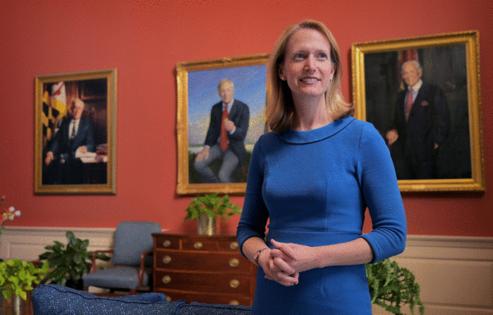Adjusting to warming world has cost Maryland billions, comptroller says
Published in Science & Technology News
Climate change has already cost Maryland between $10 billion and $20 billion in cleanup efforts following 85 extreme weather events that have hit the state since 1984, Maryland Comptroller Brooke Lierman said at a symposium Tuesday. But, she added, not preparing for continuing changes would cost the state far more in the future.
Lierman spoke at the University of Maryland, Baltimore’s Climate Health and Policy in Maryland Symposium Tuesday. She joined Maryland researchers and student interns who presented their findings on how the changing climate affects individual and public health.
Data from the National Oceanic and Atmospheric Administration backs Lierman up — the federal agency concurs that climate change has already cost Maryland $10 to $20 billion. As well, the Chesapeake Bay, which has risen by a foot in the last century, is projected to rise 5 feet over the next 100 years. Although the state plans to reduce carbon emissions with $8 billion in new investments by 2031, more frequent and intense heat waves increase the risk of heat exhaustion, stroke and heart attacks in Marylanders.
Extreme weather events take a toll on Maryland homeowners, businesses, and farms, Lierman said. They also impose a secondary cost when insurance premiums rise or homeowners cannot get insurance for hurricanes, wind, or flooding in coastal areas.
“Climate change is not just an environmental issue,” Lierman said. “It’s an economic issue, it’s a justice issue, and it’s a health issue.
“Low-income communities and communities of color are bearing the brunt of these events,” Lierman added. “They may not always have the resources to evacuate, they take longer to recover and the worsening climate takes a lasting toll on people’s health and well-being.
Extreme climate events are projected to cost the state another $27 billion by the year 2040, she said, “but of course, the longer we wait, the more expensive it gets.”
The Maryland Climate Pollution Reduction Plan seeks to reduce statewide greenhouse gas emissions by 60% by 2031, and reach net-zero emissions by 2045. The plan will require an estimated $8 billion in additional investment by 2031.
Lierman also chairs Maryland’s investment committee, which manages a $74 billion portfolio on behalf of 415,000 retired state employees.
“Even if the federal administration doesn’t believe in climate change and wants to say that climate change should not be accounted for in investment decisions,” Lierman said, “we have to take climate change into account, because it will fundamentally affect our returns.”
Rep. Andy Harris, a Republican, did not respond to request for comment by publication.
On the other hand, Lierman said investing in climate resilience has economic benefits. According to the U.S. Chamber of Commerce’s 2024 Climate Resiliency Report, every $1 invested in resilience and disaster preparedness returns $13 in avoided damages and recovery costs.
“The costs of climate change are staggering,” Lierman said, “but the costs of doing nothing are even more so.”
_____
©2025 Baltimore Sun. Visit baltimoresun.com. Distributed by Tribune Content Agency, LLC.







Comments